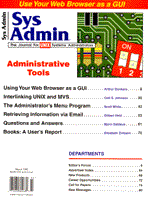
Sidebar: HTML
World Wide Web pages are written in a special language called HTML. HTML stands for HyperText Markup Language and is intended for the formatting (marking up) of text on an output device. In the case of the WWW, this output device is your favorite web browser. The HTML language is based on special "tags," which are mixed with normal text. These tags are commands to the output device to format the tagged text in a special way. For instance, the tagged text may be printed in bold, or converted into a list of items. HTML is very similar to its ancestor, SGML, but, HTML also has Hypertext capabilities. This means that the text may contain references (links) to other HTML documents (web pages) or other parts of the current document. By mixing these links with normal text, a web page gets its "webby" features, that is, being linked to other pages which themselves are also linked, and so forth (thus the name "web"). HTML has been standardized so that different browsers are still able to process the different web pages. In good Internet tradition, this standard has been recorded in a draft and can be freely obtained from a number of sources on the Net. The home base for this information is the WWW consortium, which you can reach at the following address (just point your browser and follow the links):
http://www.w3.org
When you visit this site, you will notice that a number of versions of the HTML standard are available. The most widespread is version 2.0, but the newest version, 3.0, is emerging quickly. The main difference between the versions lies in the number of tags supported and the way in which you can construct a page. Netscape deserves some special attention in this respect. Due to its market share, Netscape (sometimes referred to as "Mozilla") was able to set its own standard based on HTML 2.0. However, the Netscape implementation has some extras, such as table-formatting tags. Most of these extras have now been incorporated in the new HTML standard, version 3.0.
|